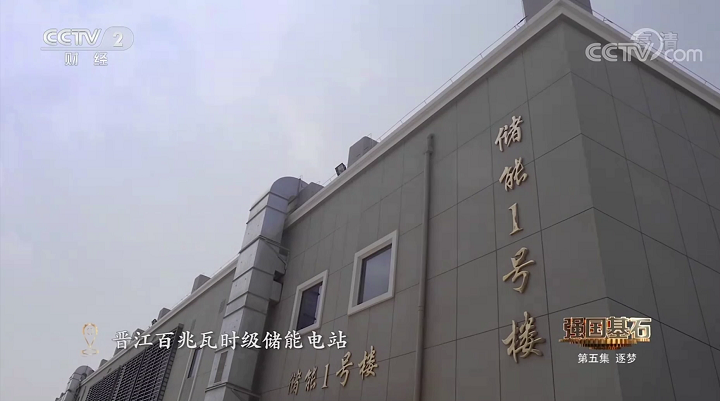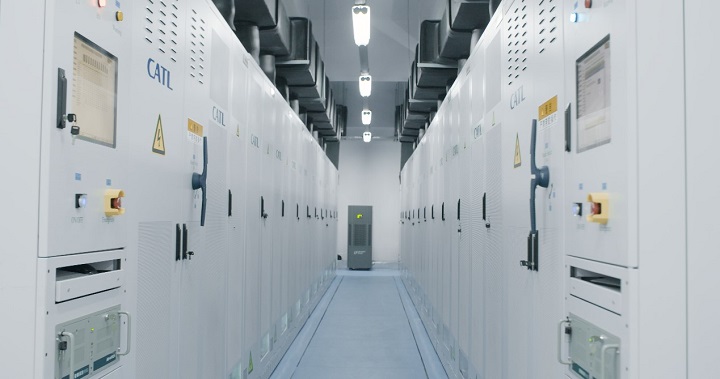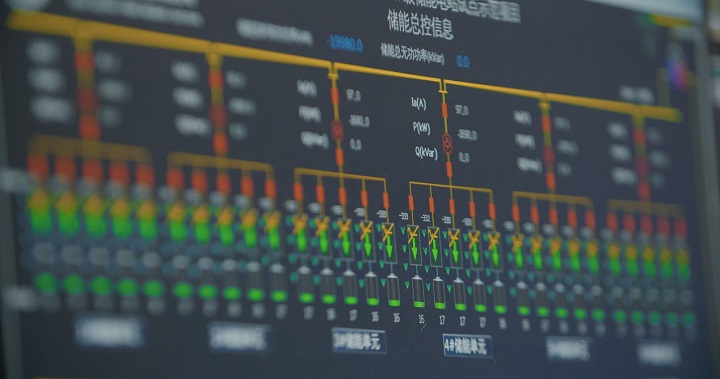A Glimpse of Jinjiang 100 MWh Energy Storage Power Station Project

China Central Television (CCTV) recently aired the documentary Cornerstones of a Great Power, which vividly describes CATL's efforts in the technological breakthrough of long-life batteries. The Jinjiang 100 MWh Energy Storage Power Station that appeared in the video is the first application of this technology.
With the goal of achieving carbon neutrality before 2060 and peaking carbon emissions before 2030, new energy power generation represented by wind and PV power generation will grow rapidly. However, the instability and intermittent nature of wind and solar power will have an impact on the safe and stable operation as well as economic efficiency of the power system. Energy storage facility is an important type of infrastructure that can enhance the flexibility of the power system, improve the utilization efficiency of wind and solar resources, and strengthen the safety and reliability of the power supply system. The cycle life of lithium-ion batteries, as a key component of the energy storage system, determines the cost of energy and is a key factor restricting its large-scale application in the field of energy storage.
On January 15, 2020, the Fujian Jinjiang Energy Storage Power Station Pilot Project Phase I (30 MW/108 MWh), the largest indoor stationary energy storage system in China constructed by CATL together with other parties, was successfully connected to the grid, providing innovative and cost-effective solutions for the promotion and application of energy storage products. The 12,000-cycle ultra-long-life energy storage batteries were used in the project for the first time, indicating that technological progress has broken through the industrial bottleneck and the energy storage market will enter a phase of fast development.
Five key technological breakthroughs to create industrial benchmark
Since 2016, the Jinjiang Energy Storage Power Station has made key technological breakthroughs for the energy storage of large-scale lithium-ion batteries including battery life cycle, energy efficiency, safety, testing and system integration:
• Ultra-long-life battery technology
• High-consistency module integration and management technology
• Highly reliable battery life prediction technology
• Safety evaluation methods and standards for units and modules in large-scale electrochemical energy storage systems
• Unified dispatching and control technology for 100 MWh large-scale battery energy storage power stations
The project has obtained 68 patents and realized the application of a 100 MWh level lithium-ion battery energy storage system in the Jinjiang 30 MW/108 MWh Energy Storage Power Station. Relying on life compensation technology, the long-life batteries are the first lithium iron phosphate (LFP) batteries with a life of over 12,000 cycles in the industry, far exceeding the average of 3,000-6,000 cycles of other products on the market. The service life is expected to exceed 20 years with charging and discharging 1.5-2.0 times a day according to local scheduling instructions.

Interior View of the Jinjiang 100 MWh Energy Storage Power Station
In addition, the 100 MWh-level unified scheduling and control technology developed by the project has realized a full power response time of less than 200 ms (the international level is more than 500 ms) and a tracking error of less than 2% (the international level is more than 3%), providing high-quality energy storage power station integration and control solutions for the promotion and application of large-capacity energy power stations and promoting the application of large-scale energy storage technologies in smart power grids.

Control System of the Jinjiang 100 MWh Energy Storage Power Station
Relying on a number of innovative technologies, the Jinjiang Energy Storage Power Station has realized smart load management to ensure the safe, stable, efficient and low-cost operation of the power grid. The power station can provide peak shaving and frequency regulation services for three 220 kV heavy-duty substations nearby, with an average daily frequency regulation capacity of up to 32,000 MW.
In 2020, the Jinjiang 100 MWh Energy Storage Power Station was selected as one of the first batches of technological innovation (energy storage) pilot projects by the National Energy Administration. In the same year, it also obtained the first power generation business license for independent storage power stations in China, marking the start of the commercial operation of energy storage power stations. As of July 1, 2021, the station has been operated safely for 535 days, with a total energy discharge of 68.52 GWh, which is equivalent to the energy consumption of more than 150,000 households based on an annual consumption of 3,000 kWh for a three-person family.
Multi-scenario promotion and application to help achieve the goal of peaking carbon emissions and achieving carbon neutrality
With the successful operation of the Jinjiang 100 MWh Energy Storage Power Station, SGCC-CATL (Fujian) Energy Storage Development Co., Ltd. (SG-CATL) and China Huadian Corporation Ltd. (CHD) also kicked off a 300 MW/600 MWh energy storage project on July 10, realizing a leap from 100 MWh to 600 MWh.
In addition, CATL’s ultra-long-life energy storage batteries have been successfully promoted and used in a number of energy storage projects integrating power generation, transmission, distribution, and consumption, providing brand-new solutions for the safe operation and effective consumption of new energy grids, promoting the development of electrochemical energy storage, and finally providing a technical basis and implementation experience for the construction of GWh-level projects.
At the same time, this technology has also been adapted for use in the field of new energy vehicle batteries. CATL has now developed batteries with a service life of 16 years and a total range of over 2 million kilometers. Their ultra-long life turns cascade utilization and V2X from theory to reality, and promotes multi-scenario applications throughout the battery life cycle.
By clicking on the button “I accept” or by further usage of this website you express consent with usage of cookies as well as you grant us the permission to collect and process personal data about your activity on this website. Such information are used to determine personalised content and display of the relevant advertisement on social networks and other websites. More information about personal data processing can be found on this link. Read More
